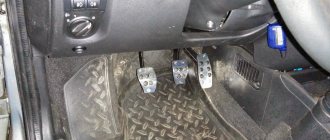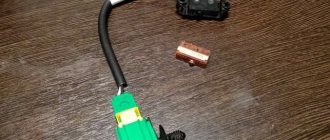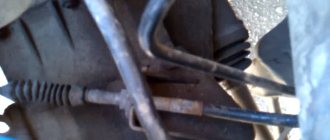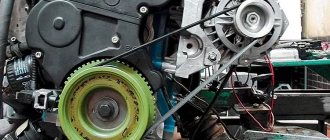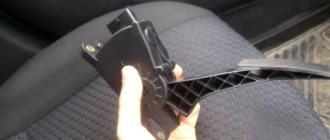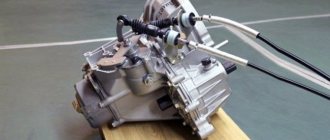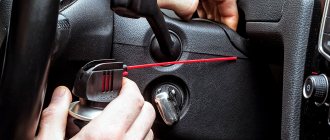VAZ cars use a clutch cable with automatic adjustment. The machine itself is a separate unit, which is fixed near the pedals. Clicking or crackling noises when the machine operates can be considered normal. But if the pedal begins to sink and the clutch does not disengage completely, then the automatic system will no longer help - you need to forcibly reduce the length of the cable. A threaded tip is provided for these purposes. That is, clutch adjustment on the Lada Grant can be done manually. Let's look at all the steps in more detail.
How can the clutch pedal click? Find out in the video.
Features of a cable gearbox on the Lada Granta
If you compare the 2180 and 2181 gearboxes, they are very different. In the old box, the driver made a lot of effort to shift, especially on previous generation cars. This was due to the fact that the previous manual transmission was based on rigid rods. A strong vibration emanated from them, transmitted into the cabin from the gearbox.
The transition to cables eliminated a number of design flaws. The gearbox now has a short stroke, making gear shifts faster. The gearbox itself consists of cables, a translator, a switching mechanism, jet thrust and a drive control device. The clutch disc has a larger diameter (215 versus 200 mm).
The main advantages of the new gearbox:
- The volume of oil poured into the box has been reduced (to 2.2 l).
- Different synchronizers were installed in first and second gear, making shifts quite easy.
- Due to the cables, vibrations and noise have been reduced. The switching itself is now clearer and without extraneous sounds. The gearbox gate on the Granta has also become quieter.
- The gearbox has become better behaved in winter conditions.
The cables themselves are supplied to the plant by the Japanese, which provides a guarantee of quality.
List of online stores selling parts (Moscow, St. Petersburg, Kyiv regions)
| № | Name | Address |
| 1. | "Doka-Market" | doka-market.prom.ua/ |
| 2. | "Ukrparts" | ukrparts.com.ua/ |
| 3. | "Amperavto" | https://amperavto.ru |
| 4. | "Grantauto" | www.grantauto.ru |
| 5. | "How much" | www.avtostore.spb.ru |
| 6. | "Online auto parts store Z24" | z24.blizko.ru/ |
When clutch adjustment is required: main signs
On average, car manufacturers recommend adjusting the clutch after a mileage of 10 thousand km.
If you observe something from this list, it means you need to make adjustments:
- Extraneous sounds, knocks when shifting into gear.
- Vibrations, if there were none before.
- Change in pedal travel, sinking or heavy movement.
- The car jerks when you start driving.
You will also have to interfere with the operation of the clutch if it is being replaced or repaired. Especially when the pedal falls out or is too hard. If the clutch is not adjusted, it may break.
Review of Manufacturer Prices
| Manufacturer, article | Price, rub.) | Resource (Thousand km) |
| Lada 21901-1602210 original | From 634 | 100 |
| ASPCC260210 | From 465 | 75 – 80 |
| BRAND 219011602210 | From 300 | 75 — 80 |
| 21901-1602266-00 | From 150 | 40 |
| 21901-1602210-00 | From 550 – 600 | 75 |
| 21901-1602210-00 | —/— | 75 |
*prices are current as of October 29, 2018.
Recommendations for the selection of parts and components
When choosing components, give preference to high-quality parts with original catalog numbers. Purchase spare parts from certified points of sale, official representative offices, and dealers. To a lesser extent, use the services of unverified intermediaries who sell products at reduced prices. Cheapness is the first sign of a fake.
Are problems with gearbox operation always associated with an unadjusted clutch?
Mechanical transmission problems do not always indicate a clutch that needs to be adjusted. If the clutch seems to be at fault, check the list above. We will also look at other problems with the manual transmission. Frequent malfunctions are:
- Gearbox noise. In neutral, this happens when the oil in the box is reduced or contaminated or the bearings wear out. In transmission, the problem may be in the synchronizer, licked teeth and dead bearings. When changing gears, the problem may be an unadjusted clutch, bearings, synchronizer, misalignment of the clutch housing and crankshaft, as well as deformed clutch forks and gearbox.
- Vibrations. Typical for internal combustion engines with disrupted operation in neutral or when fastenings are destroyed (including self-unscrewing of bolts).
- Leaking oil. The reason is most often in oil seals, gaskets, excess oil level or deformation of the transmission itself.
- The gear shifts with difficulty or does not shift at all. The problem here can also be in the clutch, as well as in other factors - contamination, lack of oil, wear of couplings, springs, gears.
- The transmission turns off by itself. There are many reasons - synchronizers, grooves, springs, spontaneous loosening of bolts and others.
Cable transmission
If you suspect clutching, take a closer look at the problem. It is far from certain that it is exactly to blame.
How long a gearbox will last depends directly on how you use the car. And the comfort, safety and controllability of your car depend on the service life of the gearbox.
If you do not want to repair the Lada Granta gearbox, follow a number of simple recommendations:
- With a manual transmission, one of the main operating factors is shifting gears with the clutch pedal fully depressed. You cannot change gears when it is not completely turned off. This leads to accelerated licking of the gear teeth. You need to choose a gear that matches your speed. It is best to move in fourth gear - it is direct and uses a minimum of gears. Accordingly, their wear is reduced. Speed range – 70-100 km/h.
- In winter, you should not leave the car in gear for a long time. This is unsafe and damages the transmission. After you start the engine, even if the car is in neutral, it may jerk.
- Lubrication of all components also has an effect. Periodically check the gearbox housing for oil leaks. They usually appear near the oil filler neck. Change your oil on time. The approximate replacement period is 50-70 thousand kilometers. Do not mix oils of different brands, as this may cause increased wear of all rubbing parts.
The recommendations are quite simple to follow. Repairing a cable transmission on a Lada Granta is neither easy nor cheap, so stick to them.
Reviews
| № | Positive |
| 1. | Vasily: I have been using the car for more than a year, there are no complaints about the quality of work, the mechanisms work properly. During the second maintenance, the technician lubricated the clutch cable because it began to squeak. |
| 2. | Kirill: Two years have passed since the purchase of the car, I have not made any investments, except for the purchase of consumables, oils, filters. |
| 3. | Ivan: at 55,000 km the clutch cable squeaked, I lubricated it myself, I didn’t contact the service center. I blame it not on the defect, but on the weather conditions, since the car is parked outside all year round. |
| 4. | Gennady: two years of driving a car without breakdowns or repairs. I am satisfied with the quality of manufacturing of domestic equipment, parts are available, wide range. My recommendations for Lada Granta drivers. |
| 5. | Vladimir: I have already completed four maintenances, no comments from the technician, only replacement of consumables, filters, oil, antifreeze. I believe that a non-aggressive driving style and high-quality spare parts are factors in the long life of the car. |
| 6. | Kirill: after 60,000 km, a metallic rattle of the cable appeared, I didn’t contact the service center, I fixed the defect on my own. The oil filling process is not complicated, and can be done by a motorist. To reinforce my knowledge, I read the recommendations in the operating instructions. |
| 7. | Dmitry: a year has passed since the purchase of the car, there are no comments on the work. I systematically carry out inspections, fill in high-quality fuel, drive carefully, and do not exceed the speed limit. |
| Negative | |
| 1. | Nikolay: my cable broke already at 35,000 km. Even for a domestic car this is too short a time. Comrades recommend purchasing a tensioner from a VAZ 2110. However, the standard fasteners do not match, you need to drill an additional one. |
| 2. | Gennady: the car began to fall apart already at 50,000 km. mileage In six months, I visited the service station three times for preventive maintenance, computer diagnostics, and replacement of worn-out elements. |
| 3. | Vladimir: over the two years of operation of the machine, he repeatedly carried out repairs, replacement of parts, and diagnostics. The quality of the components is low, I do not recommend purchasing a Lada Granta. |
How to adjust the clutch on a Grant with a cable box
On a Lada Granta car, adjusting the gearbox cables is simple. To do this you will need a set of tools:
- pliers;
- ruler;
- lubricant (silicone will do).
How to adjust the clutch on a Grant with a cable box:
- Open the hood and find the cable itself. On the Grant it is next to the left headlight.
- Measure the distance from the plastic retainer to the fork. Normal distance is 27 mm. If there is a discrepancy in the sizes, you need to rotate the lock to reduce them.
- When you release the cable, there should be no gap between the clamp and the fork. Press the pedal three times. The cable adjustment should take place on its own. After this, measure the distance of the pedal's full travel. The maximum value is 146 mm and must not be exceeded.
- Check how the pedal works. There should be no unnecessary noise, and it should be easy to press.
- Start the engine and go for a break-in. There should be no jerks when switching or slipping when starting. Gear shifting should occur without any extraneous sounds. The switching itself should be clear.
Salon "Lada Grants"
Congratulations, the gearbox cable adjustment on your Lada Granta has been successfully completed.
How to replace a broken clutch cable
Over time, with a high mileage of the car (70-75 thousand km), the cable gradually begins to fail. Since it works in tension, it wears out over time and threatens to break. If it breaks, the machine will stop. The cable can also simply become deformed from loads.
You can understand that the life of the cable is coming to an end by two signs:
- the pedal sticks;
- The pedal goes almost to the floor.
If you notice this behavior, you should replace the cable as soon as possible. It is most convenient to carry out a scheduled replacement along with other consumables - filters, oils, brake fluid - approximately once every 70 thousand kilometers.
For repairs you will need a 8mm wrench, pliers, a ruler and a new cable. To replace the cable, you need to do the following:
- Unscrew the nut securing the cable to the pedal bracket.
- Release the pin from the stop.
- Use pliers to grab the bracket and, pulling it, remove it from the pedal.
- Separate the pedal from the axle and remove the axle itself.
- Using the jaws of the pliers, engage the tip stopper, pull it out and remove it from the pedal.
- Under the hood, remove the cable seal by pulling it in the direction of travel.
- Unhook the end of the cable from the clutch fork, similarly moving it in the direction of travel.
- Put the old cable aside and take a new one.
- Insert the cable through the hole in the front shield, then secure the wear compensation mechanism to the pedal.
- Secure the shell stop to the pin where the pedals are attached.
- Install the seal on the cable.
- Screw in the leash from the lower end of the cable.
- Insert the cable into place and attach it to the clutch fork.
The clutch cable for domestic cars is inexpensive. You can easily replace it in your garage, but if you do not have such skills, then a car service center will quickly and cheaply perform this procedure. The cable itself costs 400 rubles, and the replacement cost is about 500.
Why the ECM detects error “P0830”, video explanation
Praise to the author! I am also a terrible car enthusiast, albeit with little experience... I also had right-hand drive ones, but unfortunately, they are not convenient with our traffic. I now have probably the most boring Toyota model. For almost 2 years of owning this car, I had no problems at all, it burned out once a light bulb in the foot, and I changed the brakes and oil according to plan, despite the fact that the car is 8 years old, the mileage is about 150 thousand. It accelerates quickly, drives smoothly, and is maneuverable. spacious trunk and for its size a very comfortable and spacious interior, dad feels completely comfortable in the back seat, and he is a large man. After a night in a windswept parking lot at minus 35, it started up and didn’t even sneeze once. The stove heats perfectly, the air conditioner cools quickly, the consumption is 6-7 liters of 92 in the city. engine 1.5. 106 horses, + with its size it will fit into any hole in the parking lot. In short, the car is just great. )))
I've been meaning to adjust the clutch on my Grant for a long time. I made a printout of your article. Tomorrow I’ll arm myself with the necessary tools and go to the garage to do everything with my own hands step by step, as described in the article.
Open the hood, under the air filter there is a clutch foot. It is equipped with a cable with a plastic screw. Lightly pressing the foot, remove the cable to the side. We adjust the cable screw and put it back on the foot.
When accelerating, the engine roars slightly when the leveler revs up
Clutch needs replacement! It's slipping!
When starting off there is jerking, what could be the problem?
Replacement clutch disc
I sharpened the flywheel! and he was crooked. so you can’t get away with just one disk
The clutch cable broke. I went and bought a new one. Changed it. While I was driving, the clutch was soft; accidentally, in 4th gear at 90 km/h, I jumped into 3rd gear instead of 5th. But nothing. An hour later, I noticed that when changing gears, my car seemed to be giving up gas (by the sound), but in fact I don’t know what it is. The clutch pedal has free play, i.e. hanging out. And the pedal is too soft. Can there be different clutch cables on the grant?
Source
Is the clutch adjustment different on a cable and cableless gearbox?
In recent years, manufacturers have installed only two types of clutches on cars. This is a hydraulic and mechanical drive.
The hydraulic drive is similar in design to the drive of another hydraulic system in a car - the brake drive. The operating principle is based on incompressible fluid. The clutch pedal is connected to the cylinder by a pipeline with brake fluid. This design is more complex and expensive. In addition to the pedal, the system also includes a fluid reservoir and hoses for fluid circulation. A similar drive is used on classics, as well as on new Vesta and X-Ray.
When the driver depresses the clutch pedal, the piston in the master cylinder moves due to the action of the pushrod. Liquid comes from the tank, which goes into the system to the working cylinder, moving the piston. The piston pusher presses on the clutch fork.
Mechanical drive has also been used for quite some time. It has a low price and reliability of the entire structure. In this case, a cable runs from the pedal to the clutch fork through the interior and engine compartment. What unites this all is a lever system and a mechanism for adjusting the pedal stroke. It is he who is on the Lada Granta.
When you press the pedal, the force is transferred from the pedal to the cable, and then to the lever mechanism. This allows the fork to move.
Although both types of clutch are common, the way they are adjusted is very different. The hydraulic is self-adjusting. However, adjustment is possible provided that there is a thread and nut on the slave cylinder. To make adjustments, you will need pliers and a ruler. This is how the setup process works:
- Check the clutch fluid level. It should not be more or less than the norm.
- Find an opportunity to do work under the car. We need a pit, an overpass, a lift. The car must be securely secured.
- Locate the slave cylinder pusher.
- Unhook the spring from the fork. Measure the distance from the fork to the push rod. Then pull out the plug and measure again. Check the dimensions with the documentation. Usually it is 5 mm. If the dimensions do not match, make adjustments.
- Disconnect the spring from the fork, loosen the fixing nut and start turning the adjusting nut. This way the correct dimensions are set.
You definitely need to take the car out for a break-in and check the operation of the clutch and gearbox.
Drive system design and symptoms of malfunction
The pressure mechanism is controlled by the leftmost pedal. A well-designed lever ensures easy movement of the release disc petals. In this model of machine, commands to move the fork are supplied by a cable. He “walks around” in a matching shirt. It is worth noting that an automatic cable length adjustment system is implemented here.
Symptoms of a problem
On a new car, the important pedal assembly moves easily. Violation of the factory condition requires stopping operation and identifying the reasons. Usually, along with tight movement, related symptoms occur that indicate a malfunction of the assembly module:
- Extraneous squeaks during pedal movement.
- Jerky movement of the pedal.
- The need for frequent adjustment of the idle speed of the lever.
- The machine jerks when connecting the box to the motor.
What will happen to the car if you don't adjust the clutch?
If you do not adjust the clutch on the Grant with a cable box in a timely manner, the following problems may arise:
- Clutch slipping. A similar malfunction occurs due to the lack of free play in the pedal. The transmission of torque from the flywheel and crankshaft to the gearbox and drive axle will be incomplete. The car may not move or drive slowly with the pedal fully lowered. There may be a burning smell.
- Late response to the pedal. Triggering can be either early or late. When early, the car starts moving as soon as the pedal begins to be released (there is no free play). When it’s late, the car starts moving when the pedal is almost completely released.
- The clutch does not disengage completely, the friction disc does not separate from the flywheel. The gears will shift with force, and the sound of synchronizer teeth hitting the gearbox gears will sound. Gears may lose teeth.
Gearbox 2181 turned out to be quite good. Engineers have eliminated many of the shortcomings of the previous model. Repairing a gearbox on a Lada Granta is expectedly cheaper than on other cars. Despite the fact that the shortcomings were eliminated in subsequent cars, car enthusiasts had an unpleasant impression of the new box. Other drivers are pleased with the clarity of gear shifting and the reduction in vibrations.
